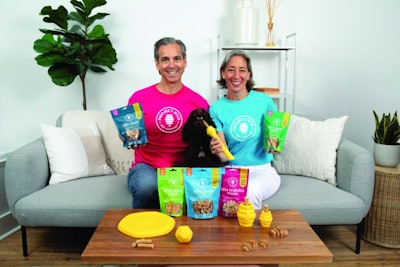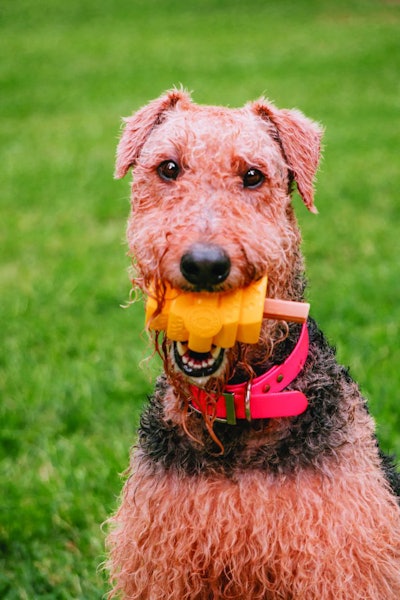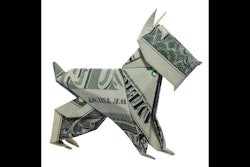
Jim Schifman and Melissa Rappaport Schifman are no strangers to business. Jim has 20 years in the pet world and 30 in retail, encompassing roles in buying, sales, startups and plenty of time in the C-suite. Melissa has more than a decade of experience in sustainable business efforts, as well as backgrounds in both finance and broader business development. As a LEED Homes Accredited Professional, in 2018 she authored a book titled, “Building a Sustainable Home: Practical Green Design Choices for Your Health, Wealth and Soul.”
So when the business partners and spouses decided to start Project Hive Pet Company, they had a decent idea of what they might be getting into. Of course, they didn’t count on a pandemic pushing their original launch plan from early 2020 to April 2021, but one year later they’re going strong and looking to expand their mission-driven enterprise that focuses on “woof-worthy dog toys and treats that help save the bees.”

“This is the perfect time to be launching a sustainable pet company, and even a step higher to a mission-driven sustainable pet company,” says Jim. “But it’s been challenging at times. When you think about what we’ve all experienced the last couple of years with COVID-19 and the supply chain, and buyers and retailers working at home, and trying to figure out how to get distribution … I think business is just more difficult today than it was two years ago in some respects.
“We originally had a plan to launch in early 2020, and [the pandemic] really put a big wrench in our launch plan,” he says. “Starting a new company in this environment, even though the pet industry is blowing up and exploding with growth, I think it makes it more difficult for a new brand to get distribution.”
Why bees?
There’s no question that a mission involving sustainability and eco-consciousness is a solid move for a new pet food company right now, at a time when more and more pet owners are looking to a brand’s story to determine whether or not they want to do business. There are a lot of ways to go in terms of trying to save the world — why bees?
“In 2008 I read an article in The Guardian (“Why Bees are the Most Invaluable Species,” November 2008) that talked about how bees were the most vital species on the planet,” says Jim. “That kind of stuck in my head over the years, and when we were thinking about a pet company and how to differentiate ourselves in the marketplace, we wanted to do something of service to our planet and help humans and pets alike.”
The mission of Project Hive Pet Company is one of habitat restoration for pollinators. The company has partnered with the Bee & Butterfly Habitat Fund, a 501.c.3 non-profit organization dedicated to the establishment of high-quality pollinator habitats to ensure the survival and growth of honeybee and monarch butterfly populations, and donates a percentage of gross sales to the Fund’s efforts.

“We have both been in the business world for the past several decades and we’ve seen a lot of decline in our ecosystem and our ability to support humans and pets and life on this planet, so using business as a force for good is something we both really wanted to do,” says Melissa. “And then we saw our opportunity in the pet industry — the bee mission is approachable and relatable. We depend on bees for much of our livelihood. They pollinate about a third of our food, and we have personally witnessed and benefitted from the work of the bees in our garden year after year. But beyond that, the reasons bee populations are declining turn out to be many of the same problems with broader sustainability issues. So, by helping bees we are helping our planet.”
To date, the company’s donations have resulted in more than 2 million square feet of healthy bee habitat planted, with a goal of planting 50 million square feet over the next five years.
First-year challenges and plans for growth
Between the standard first-year growing pains of a new company and the pandemic pains everyone is going through, it’s been a year of challenges alongside successes for Project Hive Pet Company. Distribution has been, and continues to be, a significant focus.
“Getting more distribution is really important for us,” says Jim. “What we have found is if consumers and retailers alike can find our product, then we’re confident we can win them over.”
Project Hive Pet Company has a line of five treats and five toys that they began selling on their own website. E-commerce distribution through Chewy.com, Amazon.com, Petco.com and PetSmart.com quickly followed, but the Schifmans want a solid presence in the physical space, as well.
“There is a shift from brick-and-mortar to e-commerce, but it’s still a smaller segment,” says Jim. “At the end of the day we really want to have a presence in brick-and-mortar retailers, from individual stores to regional chains to 3–5 store chains to the mass market. If you don’t have a strategy around all distribution, you don’t have a strategy.”
Gaining awareness is a significant part of distribution partnerships, and it’s a typical challenge for young companies — particularly in a market like pet care.
“As a new company and an unknown company, gaining brand awareness is a really big challenge,” says Melissa. “It’s a really crowded marketplace, and just trying to cut through all the clutter and social media and everything is really hard. We don’t have a big marketing budget to compete with the large competitors.”
The company’s treats are Non-GMO Project verified and they are currently working toward B Corp certification, which will more strongly align Project Hive Pet Company with its brand message and mission. Later in 2022 or in early 2023, the company plans to release a sixth treat type — crunchy biscuits with flavors like pumpkin, peanut butter and wild berry — as well as a peanut butter spread, both of which will work with the existing toy line. It’s safe to say that year two will be just as busy as year one, if not busier.
“We think that we’re in a really good position because of the values we’re putting into this — [values like] sustainability, USA-made, all the goodness we’ve put in our product line,” says Jim. “We think if we can get distribution out there we’ll win the consumer over because we’re novel, we’re interesting, we’re new and we’re giving them an opportunity to make an impact with their purchase.”
In the end, Project Hive Pet Company wants to help the planet — one happy dog and countless bees at a time.
Fast Facts
Headquarters: Minneapolis, Minnesota, USA
Officers: Jim Schifman, co-founder and CEO; Melissa Rappaport Schifman, co-founder and CSO/CFO
Brands: Project Hive Pet Company
Website/Social Media: www.projecthivepetcompany.com; @projecthivepetcompany on Facebook and Instagram; @projecthivepet on Twitter
Notable:
In the last year, we have created over 2 million square feet of pollinator habitat!















